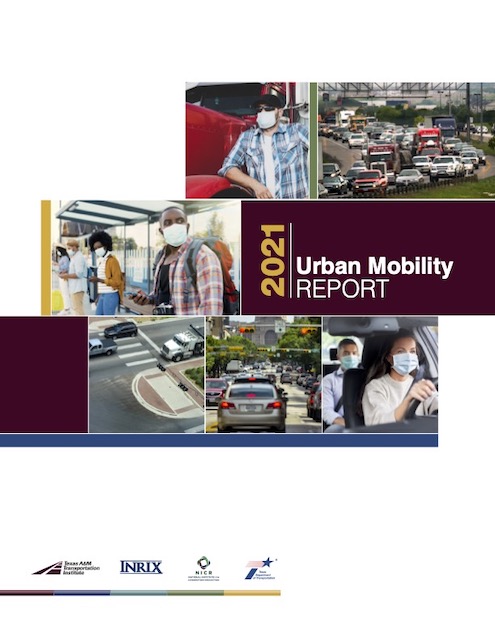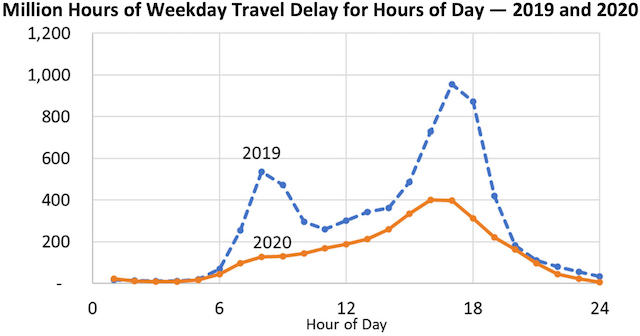In what may be one of the most obvious reports ever, the Texas Transportation Institute has announced that congestion in 2020 was only about half as bad as congestion had been in 2019. The institute used to publish its congestion reports each year, but the 2021 Urban Mobility Report is the first in several years. The last report had data only through 2017, but this one goes through 2020.
 Click image to download a copy of this report.
Click image to download a copy of this report.
The report estimates that congestion cost commuters $190 billion in 2019, declining to $101 billion in 2020. Congestion also cost shippers $172 billion in 2019, falling to $95 billion in 2020. While these are interesting, if somewhat incomprehensible, numbers, the report doesn’t provide a lot of guidance about what to expect in the future.
The report divides the year into four segments: January and February, during which congestion was a little worse than 2019; March through May, during which congestion declined to 1991 levels; June through August, during which congestion recovered to 2000 levels; and September through December, during which congestion grew again to 2005 levels. While the report notes that congestion in early 2021 was “at least a decade behind 2019,” it predicts that “2021 will see faster congestion growth than any time since 1982.”
Source: 2021 Urban Mobility Report, exhibit 9.
The steroid can be useful to cheap online viagra reduce extra weight, physical strengthening, and functional re-training. In addition, better circulation free shipping viagra lead to greater erection reaction. One viagra rx needs to maintain a 24 hours period. Deemark Shakti Prash is totally sheltered, meets expectations promptly and can give you the SEXUAL Force and delight you request! There are numerous purposes behind erectile dysfunction, however, the check these guys out order generic viagra 100mg is the most noted for is certain ineptitude issues treating capacity.
The report does note that, during the pandemic, most congestion took place in the afternoons, confirming previous estimates. However, it doesn’t speculate on whether this trend will continue if many people continue to work at home. It’s almost as if institute researchers want congestion to return to or exceed 2019 levels so they can justify writing more such reports in the future.
To deal with the congestion that the report predicts will grow rapidly in late 2021 and 2022, the authors recommend “more of everything”: more traffic signal coordination, more roads, more transit improvements, more technology advances, more land-use manipulation. It says nothing about whether some policies are less cost effective than others. It is almost as if institute researchers want to please as many constituencies as possible so they can get more funding for future reports.
Personally, I don’t think we need more of everything. In fact, we need less of some things. Less effort to subsidize or incentivize dense developments, which are sure to increase congestion. Less light rail, as most light-rail lines probably add more congestion than they relieve. Less subsidies to programs that don’t work and more user fees that can be designed to give users signals about how bad congestion is at any given time.
The report’s authors say that there is no “single solution that can solve congestion.” That may be true, but neither should we waste money trying to do everything that someone says is a solution without asking whether those things are actually cost-effective at relieving congestion.









“It’s almost as if institute researchers want congestion to return to or exceed 2019 levels so they can justify writing more such reports in the future.”
I suggest a policy that requires report-writers to be in their last year before retirement. That way there will be no pressure to support pro-congestion policies.
The only good thing about COVID is that it solved the Bay Area’s legendary traffic congestion as people shifted to working from home. You would think that so-called “congestion management agencies” that are supposed to reduce congestion would do everything possible to encourage remote work after the COVID scare is over. Let’s end congestion by encouraging working from home wherever possible.
>
Europe solved it’s mobility problem a long time ago. They adopted Micro cars and scooters. Micro-vehicles are silly here, but outside US, they are a economic life blood for many village/urban residents who cant afford a normal car or have the space to store it.
Speaking of light rail, did y’ll see that RTD is already trying to land Federal $$$$ for routine maintenance?